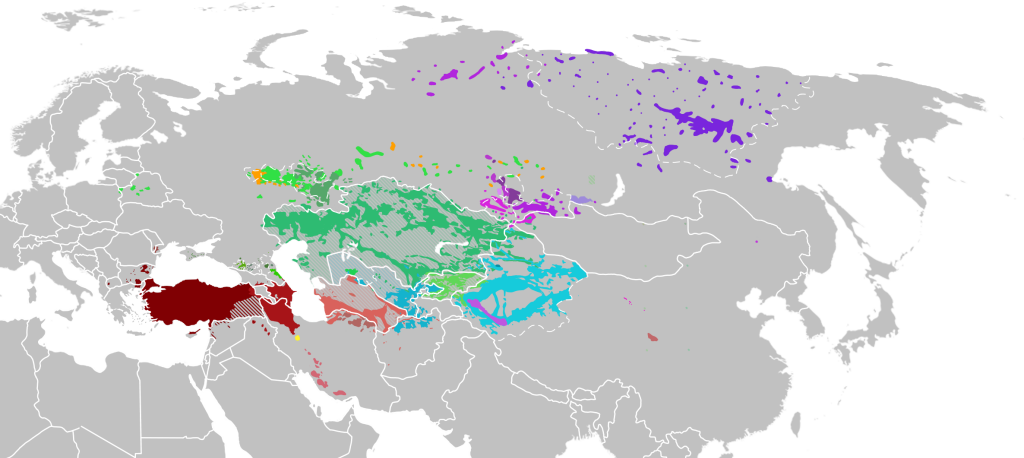The Jordan Center stands with all the people of Ukraine, Russia, and the rest of the world who oppose the Russian invasion of Ukraine. See our statement here.
Above: A 2022 map showing the distribution of Turkic languages across Eurasia.
Oğul Tuna is a Ph.D. student in the History Department at the University of California, Irvine. His research treats the interplay of nationalism and socialism during the Sovietization of the South Caucasus.
After three waves of alphabet reform, the policy of Latinization (latinizatsiya) in Central Asia has remained at the heart of national, social, and political issues for more than a century. Launched by the first generations of Turkic intellectuals, the Latin alphabet project was conceived as a departure from the Islamic past and a step toward socio-cultural renaissance among the Turkic peoples of the Russian Empire. Paradoxically, this emancipatory mission developed during the first decade of the Soviet regime—on territories mainly populated by Turkic peoples—in the name of eliminating illiteracy and religious, feudal, and national ties.
Barely a decade after the new Turkic alphabet was introduced, a new campaign, this time for Cyrillization, resulted in all the Turkic republics adopting Cyrillic script in 1939—a decision that would remain in force even after these states gained their independence.
In the early twentieth century, use of the Latin alphabet came under heavy criticism; today, it is Cyrillic script that is coming under fire. Rejection of Russian dominance and growing nationalism is compelling governments to take measures in cultural fields. Russian is rapidly losing its status as Kazakhstan and Uzbekistan prepare for an alphabet change in the 2020s. Kyrgyzstan, too, has recently seen a resurgent nationalist discourse that calls for a return to Latin script.
To better understand the Latin alphabet as a political apparatus of identity construction in formerly Soviet territories, it is necessary to examine Latinization policies over the last century.
Sovietization: the first wave of Latinization (1924-1939)
From the mid-nineteenth century forward, Turkic intellectuals explicitly opposed using the Arabic script, which was perceived as failing to match Turkic languages due to its limited number of vowels.
Mirzə Fətəli Akhundov was the first major critic of Arabic script, instead favoring the Latin one, which he proposed as part of a more general Ottoman language reform during the Tanzimat era (1839-1876). However, his idea proved too radical for some of his contemporaries, who believed it to imply a rejection of Islam.
The fierce debates among Turkic intellectuals ended with a Bolshevik-imposed adoption of Latin script in the region. This alphabet change went hand in hand with early-Soviet ideals of internationalism, Sovietization, and proletarianization. Soviet language policy, which proposed equality among all languages, was part of a greater policy of so-called "nativization [korenizatsiya]," which aimed to bring indigenous peoples into the Soviet labor force as members of one nation. Latin script was accordingly placed at the center of cultural construction, women's liberation, and literacy.
The first attempt at Latinization came with the Yakut language, which had already been partially Latinized as early as 1919. Major reforms for Latinization were advocated for Uzbeks in 1921 and for Kazakhs in 1923. However, it was Azerbaijan that implemented the first official policy of Latinization in the Turkic world. All Turkic Soviet republics had to declare the new unified Turkic alphabet as their official script by January 1, 1929. By 1936, the introduction of the new alphabet was complete, although it would not last long.
One unintended consequence of this unification, from the Kremlin's perspective, was greater potential for the development of local nationalisms, since the literary language of the various Turkic peoples was now one and the same.
Just three years later, Turkic languages underwent another script change—this time, a Russifying shift to Cyrillic. The move from one script to the other was gradual, and without the debate that had surrounded Latinization. Cyrillic was adopted in Azerbaijan in 1940, with Central Asian republics following suit between 1939 and 1941.
Nationalization: The Latin script as a component of the nation-state (1991-2025)
After the Soviet Union collapsed and Turkic states began gaining their independence, they had the chance, for the first time, to reflect on and adopt alphabets of their choosing.
Central Asia's current process of Latinization is strongly linked to the legitimization of power, the construction of postcolonial identity, and the search for geopolitical balance between Russia and Turkey. At the same time, each state had its own agenda.
In Azerbaijan, debates on Latinization began in 1989, culminating in a law imposing alphabet change in 1991. However, it was not until June 2001, following a decree by President Heydər Əliyev, that all official documents, newspapers, books, and street signs began to shift to Latin script. Turkmenistan followed in Azerbaijan's footsteps, making an almost total shift to Latin script in 1993.
Uzbekistan's transition to Latin script was much slower. Initially, four main motivations spoke in favor of the shift: to strengthen the sovereign status of a newly independent state; to protect against the radicalization associated with Arabic writing; to promote modernization and Westernization; and to obtain Turkish financial support. Though the Uzbek Parliament passed the first law on Latinization as early as September 1993, it took until 2021 for the Office of the Uzbek President—who heads an administration that is much more pro-Western and pro-Turkish than its predecessors—to announce a plan for total Latinization.
In Kazakhstan, demography and geopolitics are crucial to decision-making around the alphabet question. The number of Latinization's defenders has increased in recent years with the rise of Kazakh nationalism. State officials again raised the idea of switching to Latin script in 2002, but it was not until 2007 that then-President Nazarbayev took up the issue. Years passed; finally, in 2017, Nazarbayev issued a decree establishing a new alphabet for the Kazakh language based on the Latin script—a move that the Russian state found worrisome.
Kyrgyzstan, meanwhile, has invested little effort in Latinization. While this attitude may be traced to the country's Russian population, Russian state influence also plays a role. Bishkek receives more Russian money than any other Central Asian state and hosts a Russian military base on its territory. It is also the only Central Asian republic to grant the Russian language official status in a May 2000 law.
Conclusion
A total change from one alphabet to another requires coordinated efforts by government officials, as well as the widespread support and participation of the public. Other factors crucial to the success of such a shift include economic resources to finance new textbooks and technologies and support from linguistic spheres to guide the transformation. In the early twentieth century, the Soviets were able to push through their alphabet reforms precisely because they possessed these resources while the young Turkic states lacked them. At the time, the Bolshevik leadership saw Latinization as part of a civilizing project in Central Asia. Today, the Kremlin treats movements for alphabet reform as evidence of nationalism and indications of waning Russian influence.
Rising nationalism contributes to Latinization but threatens inter-ethnic relations. Turkic states still perceive the Latin script as an object of negotiation between regional powers. The recent crisis in Kazakhstan in January 2022 was an exemplary case. When the Russian military stepped in as a peacekeeping force, experts saw an extreme Kremlin reaction to the country's de-Russification policy, which peaked with the adoption of Latin script. Thus, Latinization policy has already been internationalized, after first being Sovietized and nationalized.



